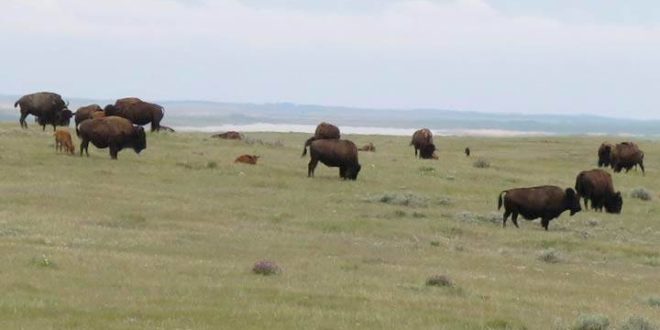The tiny community of , Sask., isn’t exactly a mecca. Located in the southwest corner of the province, 150 kilometres south of Swift Current, Claydon has a post office, a couple of other buildings and little in the way of tourist amenities.
But what it does have is – roaming the grasslands of the Old Man on His Back Prairie and Heritage Conservation Area – to the west.
The conservation area is a 5,300-hectare parcel of grassland owned by the Nature Conservancy of Canada along with the Saskatchewan government.
It’s home to bird species at risk such as the Chestnut-collared Longspur and the most-recently spotted ferruginous hawks. But the big draw to the area is a herd of about 80 bison that were reintroduced to the area nearly 15 years ago from Elk Island National Park in Alberta.
It’s estimated that there were once about 60 million bison in North America, but the animals were almost completely wiped out about a century ago when they were hunted for nothing more than their tongues or their horns.
At the turn of the last century, the last large herd of wild bison on the Montana plains was bought by the Canadian government and moved to what would become the Elk Island park.
In recent years, genetically purebred bison, with no trace of beef DNA, have been shipped from Elk Island around North America in an effort to restore the animals to the landscape.
“We attract a lot of hikers and a lot of birders, that’s for sure. We have a few species at risk on the property – particularly bird species at risk. We don’t have any hiking trails but people are allowed to just kind of roam freely,” said Kylie Garchinski, acting natural areas manager for southwestern Saskatchewan for the Nature Conservancy of Canada.
Garchinski said no vehicles are allowed on the property but visitors willing to hike out into the grazing area are welcome to do so.
“Definitely it’s super exciting for the people who get to see the bison. It’s not guaranteed but you’re welcome to walk out in their pasture. We just ask people that they keep a reasonable distance from them.”
There is also an interpretive centre at the conservancy area open from May until September. The name and phone number of the interpretive guide is listed on the door. Anyone wanting to get into the centre or to arrange private tours only has to phone him.
If visitors are lucky, they’ll see the massive bison along the road entering the conservation area, Garchinski said. But it’s worth the effort to go on foot and see them on the open prairie.
“It’s unfortunate that you can’t get super close to them but you get to see them how they would have been 200 years ago, roaming on the landscape, so that’s the neat part of it,” she said.
“It’s not a petting zoo. You get to see them in their natural habitat, which is nice.”
Garchinski said it’s difficult to estimate how many hikers enter the area every year but there have been visitors from across Canada, England and Sweden who have signed the guest book at the interpretive centre.
“Word gets out and we have people from all over the place so that’s pretty neat too,” she said.
—
If You Go…
Visit the T. rex Discovery Centre in Eastend, Sask., best known for the discovery of a Tyrannosaurus rex skeleton nicknamed “Scotty” in 1994.Visit Grasslands National Park near the village of Val Marie, which protects one of the nation’s few remaining areas of undisturbed dry mixed-grass/shortgrass prairie grassland.
[ad_2]
You can read more of the news on source
 Travelsmart
Travelsmart



